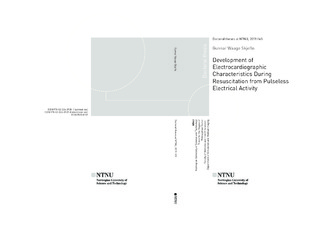| dc.contributor.advisor | Skogvoll, Eirik | |
| dc.contributor.advisor | Nordseth, Trond | |
| dc.contributor.advisor | Loennechen, Jan Pål | |
| dc.contributor.author | Skjeflo, Gunnar Waage | |
| dc.date.accessioned | 2019-07-23T08:16:51Z | |
| dc.date.available | 2019-07-23T08:16:51Z | |
| dc.date.issued | 2019 | |
| dc.identifier.isbn | 978-82-326-3929-8 | |
| dc.identifier.issn | 1503-8181 | |
| dc.identifier.uri | http://hdl.handle.net/11250/2606256 | |
| dc.description.abstract | Background
Pulseless electrical activity (PEA) refers to patients in cardiac arrest in whom the electrocardiogram (ECG) shows organized electrical activity. In cardiac arrest in hospital, PEA is the presenting rhythm in around 40% of cases. In the out-of-hospital setting, PEA is the presenting rhythm in about 20% of cardiac arrests. The ECG is a recording of the electrical activity of the heart, and is widely used in diagnosis of heart disease and monitoring of heart function. The presence of ECG complexes represents a possible source of information during PEA. The development of ECG characteristics during the provision of advanced life support (ALS) for cardiac arrest with PEA has not been investigated previously.
Aims of the Thesis
1. To describe the development of ECG characteristics during ALS in patients with and without return of spontaneous circulation (ROSC).
2. To explore the effect of intravenous adrenaline on the development of the ECG characteristics during ALS.
3. To investigate the development of ECG characteristics based on the cause of cardiac arrest.
Methods
We measured QRS complex width (the duration of ventricular depolarization) and QRS complex rate (heart rate) at all pauses in compression during the provision of ALS. Studies I and III included patients with cardiac arrest at St. Olav University Hospital, Trondheim, Norway. Study II included patients with cardiac arrest out-of-hospital in the city of Oslo, Norway, that were originally part of a randomized controlled trial of intravenous access during ALS. We examined whether QRS complex width and heart rate during ALS were related to whether ROSC was obtained or not (all three studies), whether adrenaline was administered (study II), and whether there was a cardiac or other, non-cardiac etiology of arrest (study III). Statistical methods included correlation analysis, multivariate analysis of variance, analysis of covariance, and various mixed model methods.
Results
In studies I and II, we found that the pattern of change in QRS width and heart rate differed between patients who obtained and did not obtain ROSC. More specifically, QRS width decreased and heart rate increased in patients who obtained ROSC. This difference was consistent in the in- and out-of-hospital populations. In study II, we found that heart rate increased in patients who received adrenaline during ALS, more in patients who obtained ROSC, but also in patients who did not obtain ROSC. Study III showed that the development in QRS width differed between patients with a cardiac etiology of arrest compared to patients with other etiologies; QRS was wider in the cardiac etiology patients, but narrowed in those that did obtain ROSC. In the other etiology groups, QRS width was narrower throughout ALS.
Conclusion
QRS narrowed and heart rate rose during the provision of ALS for cardiac arrest with PEA in patients who did obtain ROSC, but not in those who died. The same pattern of change in QRS width and heart rate was seen in the in-hospital and out-of-hospital populations studied. Heart rate increased in patients who did get adrenaline during ALS out-of-hospital, even if they did not obtain ROSC. QRS width was wider in patients with cardiac etiology of in-hospital cardiac arrest, but narrowed in those who obtained ROSC. Patients with other, non-cardiac, etiologies had narrower QRS widths that did not change during ALS. | nb_NO |
| dc.language.iso | eng | nb_NO |
| dc.publisher | NTNU | nb_NO |
| dc.relation.ispartofseries | Doctoral theses at NTNU;2019:165 | |
| dc.relation.haspart | Paper 1: Skjeflo, Gunnar Waage; Nordseth, Trond; Loennechen, Jan Pål; Bergum, Daniel; Skogvoll, Eirik. ECG changes during resuscitation of patients with initial pulseless electrical activity are associated with return of spontaneous circulation. Resuscitation 2018 ;Volum 127. s. 31-36
- This is an open access article under the CC BY-NC-ND license (http://creativecommons.org/licenses/BY-NC-ND/4.0/).
https://doi.org/10.1016/j.resuscitation.2018.03.039 | nb_NO |
| dc.relation.haspart | Paper 2: Skjeflo, Gunnar Waage; Skogvoll, Eirik; Loennechen, Jan Pål; Olasveengen, Theresa M.; Wik, Lars; Nordseth, Trond. The effect of intravenous adrenaline on electrocardiographic changes during resuscitation in patients with initial pulseless electrical activity in out of hospital cardiac arrest. Resuscitation 2019 ;Volum 136. s. 119-125
- This is an open access article under the CC BY-NC-ND license (http://creativecommons.org/licenses/by-nc-nd/4.0/).
https://doi.org/10.1016/j.resuscitation.2019.01.021 | nb_NO |
| dc.relation.haspart | Paper 3: Skjeflo GW, Bergum D, Loennechen JP, Nordseth T, Skogvoll E. Changes in QRS Complex Width during Resuscitation Depend on Aetiology in Patients with Pulseless Electrical Activity | nb_NO |
| dc.title | Development of Electrocardiographic Characteristics During Resuscitation from Pulseless Electrical Activity | nb_NO |
| dc.type | Doctoral thesis | nb_NO |
| dc.subject.nsi | VDP::Medical disciplines: 700 | nb_NO |
